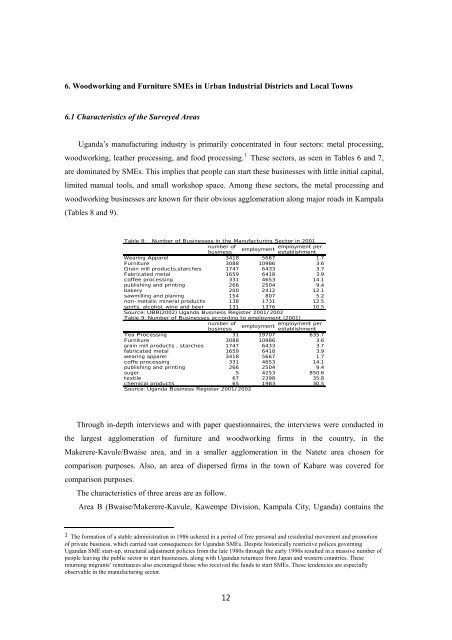Information - ARRIDE - IDE-JETRO
Information - ARRIDE - IDE-JETRO
Information - ARRIDE - IDE-JETRO
Create successful ePaper yourself
Turn your PDF publications into a flip-book with our unique Google optimized e-Paper software.
6. Woodworking and Furniture SMEs in Urban Industrial Districts and Local Towns<br />
6.1 Characteristics of the Surveyed Areas<br />
Uganda’s manufacturing industry is primarily concentrated in four sectors: metal processing,<br />
woodworking, leather processing, and food processing. 1 These sectors, as seen in Tables 6 and 7,<br />
are dominated by SMEs. This implies that people can start these businesses with little initial capital,<br />
limited manual tools, and small workshop space. Among these sectors, the metal processing and<br />
woodworking businesses are known for their obvious agglomeration along major roads in Kampala<br />
(Tables 8 and 9).<br />
<br />
<br />
<br />
<br />
<br />
<br />
<br />
<br />
<br />
<br />
<br />
<br />
<br />
<br />
<br />
<br />
<br />
<br />
<br />
<br />
<br />
<br />
<br />
<br />
<br />
<br />
<br />
<br />
<br />
<br />
<br />
<br />
Through in-depth interviews and with paper questionnaires, the interviews were conducted in<br />
the largest agglomeration of furniture and woodworking firms in the country, in the<br />
Makerere-Kavule/Bwaise area, and in a smaller agglomeration in the Natete area chosen for<br />
comparison purposes. Also, an area of dispersed firms in the town of Kabare was covered for<br />
comparison purposes.<br />
The characteristics of three areas are as follow.<br />
Area B (Bwaise/Makerere-Kavule, Kawempe Division, Kampala City, Uganda) contains the<br />
1 The formation of a stable administration in 1986 ushered in a period of free personal and residential movement and promotion<br />
of private business, which carried vast consequences for Ugandan SMEs. Despite historically restrictive polices governing<br />
Ugandan SME start-up, structural adjustment policies from the late 1980s through the early 1990s resulted in a massive number of<br />
people leaving the public sector to start businesses, along with Ugandan returnees from Japan and western countries. These<br />
returning migrants’ remittances also encouraged those who received the funds to start SMEs. These tendencies are especially<br />
observable in the manufacturing sector.<br />
12




![Title [書評] 廣田義人著『東アジア工作機械工業の技術形成 ... - ARRIDE](https://img.yumpu.com/47139953/1/184x260/title-arride.jpg?quality=85)






